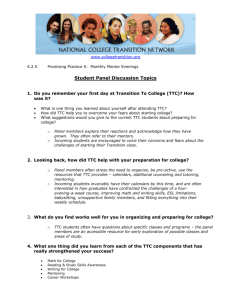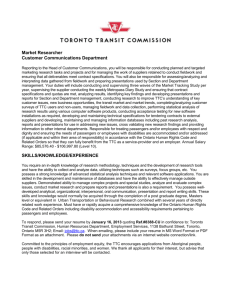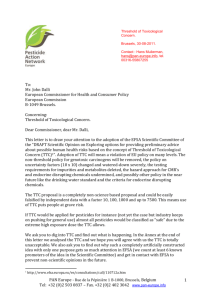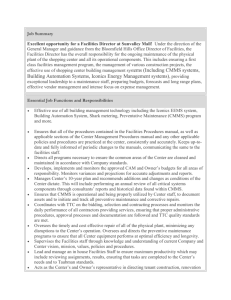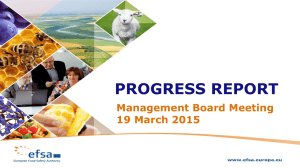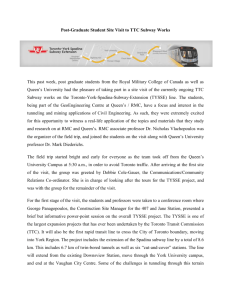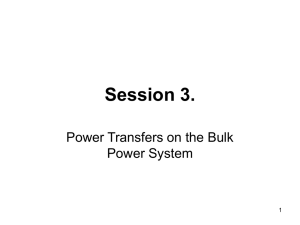PAN Europe report on EFSA and TTC
advertisement
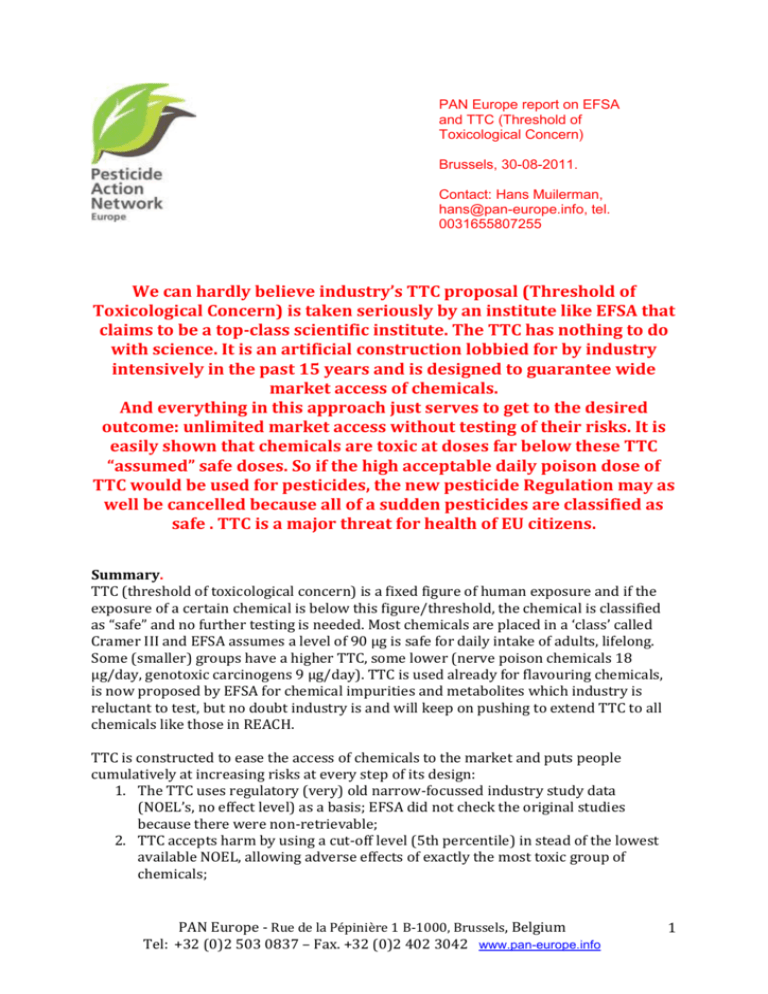
PAN Europe report on EFSA and TTC (Threshold of Toxicological Concern) Brussels, 30-08-2011. Contact: Hans Muilerman, hans@pan-europe.info, tel. 0031655807255 We can hardly believe industry’s TTC proposal (Threshold of Toxicological Concern) is taken seriously by an institute like EFSA that claims to be a top-class scientific institute. The TTC has nothing to do with science. It is an artificial construction lobbied for by industry intensively in the past 15 years and is designed to guarantee wide market access of chemicals. And everything in this approach just serves to get to the desired outcome: unlimited market access without testing of their risks. It is easily shown that chemicals are toxic at doses far below these TTC “assumed” safe doses. So if the high acceptable daily poison dose of TTC would be used for pesticides, the new pesticide Regulation may as well be cancelled because all of a sudden pesticides are classified as safe . TTC is a major threat for health of EU citizens. Summary. TTC (threshold of toxicological concern) is a fixed figure of human exposure and if the exposure of a certain chemical is below this figure/threshold, the chemical is classified as “safe” and no further testing is needed. Most chemicals are placed in a ‘class’ called Cramer III and EFSA assumes a level of 90 µg is safe for daily intake of adults, lifelong. Some (smaller) groups have a higher TTC, some lower (nerve poison chemicals 18 µg/day, genotoxic carcinogens 9 µg/day). TTC is used already for flavouring chemicals, is now proposed by EFSA for chemical impurities and metabolites which industry is reluctant to test, but no doubt industry is and will keep on pushing to extend TTC to all chemicals like those in REACH. TTC is constructed to ease the access of chemicals to the market and puts people cumulatively at increasing risks at every step of its design: 1. The TTC uses regulatory (very) old narrow-focussed industry study data (NOEL’s, no effect level) as a basis; EFSA did not check the original studies because there were non-retrievable; 2. TTC accepts harm by using a cut-off level (5th percentile) in stead of the lowest available NOEL, allowing adverse effects of exactly the most toxic group of chemicals; PAN Europe - Rue de la Pépinière 1 B-1000, Brussels, Belgium Tel: +32 (0)2 503 0837 – Fax. +32 (0)2 402 3042 www.pan-europe.info 1 3. TTC disregards independent scientific research on chemicals and the much lower data available to falsify these alleged industry “no-effect” data 4. TTC disregards chemical mixtures to which humans are exposed 5. TTC ignores effects on vulnerable groups like foetus and infants 6. TTC allows lifetime human exposure likely calculating/estimating average intake masking peak/acute doses 7. TTC disregards decades of scientific progress ao. on vulnerable windows of exposure during development with epigenetic processes, EFSA even includes endocrine disrupting chemicals; TTC once was intended and used only to get an indication of risk; now its many proponents have crossed a line of justifiability saying it guarantees safety, a claim which is not based on science but on statistical juggling and old unverifiable data which are false; Our comments in more detail. I. The TTC construction is not applicable for risk management. TTC is an obvious manipulation of the industry database by using a cut-off level of 5th percentile of the data instead of using the lowest data; pesticide Dieldrin is 30x more toxic than the NOEL were the “safe level” of TTC is based upon. TTC this way removes largely the uncertainty factors of vulnerability, risk assessment policy used for decades. TTC is scientifically flawed because it allows one chemical to occupy the complete ‘pollution space’ in human food (3 kg of food is allowed to be fully polluted by one chemical to the TTC level) completely ignoring the exposure of humans to hundreds of other harmful chemicals every day; Infants are not protected by TTC. Development causes far greater numbers of genes to be active, and in a much more complicates fashion than adults; a process very vulnerable to insult. EFSA acknowledges infants are more vulnerable, having not only less capacity of renal clearance and less detoxifying enzymes but also has more food intake and different diets, estimated by EFSA to be 2-5x more vulnerable. EFSA though assumes –based on no science- there is an opportunity to use TTC, saying: “careful consideration needs to be given to whether the TTC approach should still be applied”; Even industry (Kroes, 20041) concludes TTC cannot be used for endocrine disrupting chemicals (EDC’s) because of the uncertainty of low-dose effects; EFSA however assumes TTC is safe for EDC’s. A quick scan by PAN Europe of research data (Table below) shows industry is right and EFSA wrong; Chemical (Endocrine disruptor /Cramer III Bisphenol A Fenarimol Independent studies NOEL/LOEL* (findings in µg/kg bw.) that are lower than ‘safe’ TTC-NOEL of 150 µg/kg 2 (LOEL, mice**) 2 (LOEL, mice2) 1 Kroes R, Renwick A G, Cheeseman M A, Kleiner J, Mangelsdorf I, Piersma A, Schilter B, Schlatter J, van Schothorst F, Vos J G, Wurtzen G, 2004. Structure-based thresholds of toxicological concern (TTC): guidance for application to substances present at low levels in the diet. Food and Chemical Toxicology 42: 65-83. 2 Mira Park, Jiyou Han, Jeong-Jae Ko, Woo-Sik Lee, Tae Ki Yoon, Kangseok Lee, Jeehyeon Bae, Maternal exposure to fenarimol promotes reproductive performance in mouse offspring, Toxicology Letters 205 (2011) 241– 249 PAN Europe - Rue de la Pépinière 1 B-1000, Brussels, Belgium Tel: +32 (0)2 503 0837 – Fax. +32 (0)2 402 3042 www.pan-europe.info 2 DES Atrazin PBDE-99 Nonylphenol Di-n-butyl phthalate Hexachlorobenzene + 123trichlorobenzene BDE-47 Perchlorate Methoxychlor Octylphenol Deltamethrin 0,p’-DDT PFOA Ethinylestradiol 0,02 (LOEL, mice**) 1 (LOEL, mice3) 60 (LOEL, rats4) 100 (LOEL,rats5) 10 (LOEL, rats6) 0,1 (LOEL, rats7) 2 (LOEL, rats8) 0,2 (LOEL, lambs9) 10 (LOEL, rats10) 20 (LOEL, mice11) 10 (LOEL, pigs12) 3 (LOEL, rats13) 18 (LOEL, mice14) 10 (LOEL, mice15) 0,2 (LOEL, rats16) 3 V. Belloni, E. Alleva, F. Dessì-Fulgheri, M. Zaccaroni and D. Santucci, Effects of low doses of atrazine on the neurobehavioural development of mice, Ethology Ecology & Evolution 19: 309-322, 2007 4 Sergio Noboru Kuriyama, Antonia Wanner, Antonio Augusto Fidalgo-Neto, Chris E. Talsness, Wolfgang Koerner and Ibrahim Chahoud, Developmental exposure to low-dose PBDE-99: Tissue distribution and thyroid hormone levels, Toxicology,Volume 242, Issues 1-3, 5 December 2007, Pages 80-90 5 Po-Ling Yu, Han-Wei Lin Shyi-Wu Wang and Paulus S.Wang, Effects of Nonylphenol on the Production of Progesterone on the Rats Granulosa Cells, May 11, 2011, Journal of Cellular Biochemistry, DOI 10.1002/jcb.23189. 6 Hideo Hoshi and Teruya Ohtsuka, Adult Rats Exposed to Low-Doses of Di-n-Butyl Phthalate During Gestation Exhibit Decreased Grooming Behavior, Bull Environ Contam Toxicol (2009) 83:62–66. 7 Z. Valkusz, G. Nagyéri, M. Radács, T. Ocskó, P. Hausinger, M. László, F.A. László, A. Juhász, J. Julesz, R. Pálföldi, M. Gálfi, Further analysis of behavioral and endocrine consequences of chronic exposure of male Wistar rats to subtoxic doses of endocrine disruptor chlorobenzenes, Physiology & Behavior 103 (2011) 421–430. 8 Alexander Suvorov and Larissa Takser, Delayed response in the rat frontal lobe transcriptome to perinatal exposure to the flame retardant BDE-47, J. of Appl. Toxicology, 11 March 2011 online. 9 Nadia Abdelouahab, Alexander Suvorov, Jean-Charles Pasquier, Marie-France Langlois, Jean-Paul Praud, Larissa Takser, Thyroid Disruption by Low-Dose BDE-47 in Prenatally Exposed Lambs, Neonatology 2009;96:120–124 10 Kyung O. Yu, Latha Narayanan, David R. Mattie, Richard J. Godfrey, Paula N. Todd, Teresa R. Sterner, Deirdre A. Mahle, Michael H. Lumpkin and Jeffrey W. Fisher, The Pharmacokinetics of Perchlorate and Its Effect on the Hypothalamus–Pituitary–Thyroid Axis in the Male Rat, Toxicology and Applied Pharmacology Volume 182, Issue 2, 15 July 2002, Pages 148-159. 11 Laura Gioiosa, Elena Fissore, Giorgia Ghirardelli, Stefano Parmigiani, Paola Palanza, Developmental exposure to low-dose estrogenic endocrine disruptors alters sex differences in exploration and emotional responses in mice, Hormones and Behavior 52 (2007) 307–316. 12 I. B. Bøgh, P. Christensen, V. Dantzer, M. Groot, I. C. N. Thøfner, R. K. Rasmussen, M. Schmidt and T. Greve, Endocrine disrupting compounds: effect of octylphenol on reproduction over three generations, Theriogenology Volume 55, Issue 1, 1 January 2001, Pages 131-150. 13 Issam C, Samir H, Zohra H, Monia Z, Hassen BC, Toxic responses to deltamethrin (DM) low doses on gonads, sex hormones and lipoperoxidation in male rats following subcutaneous treatments, J Toxicol Sci. 2009 Dec;34(6):663-70. 14 Palanza P , Parmigiani S , Liu H , vom Saal FS ., Prenatal exposure to low doses of the estrogenic chemicals diethylstilbestrol and o,p'-DDT alters aggressive behavior of male and female house mice, Pharmacol Biochem Behav. 1999 Dec;64(4):665-72. 15 Macon MB , Villanueva LR , Tatum-Gibbs K , Zehr RD , Strynar MJ , Stanko JP , White SS , Helfant L , Fenton SE ., Prenatal Perfluorooctanoic Acid Exposure in CD-1 Mice: Low-Dose Developmental Effects and Internal Dosimetry, Toxicol Sci. 2011 Jul;122(1):134-45. Epub 2011 Apr 11. PAN Europe - Rue de la Pépinière 1 B-1000, Brussels, Belgium Tel: +32 (0)2 503 0837 – Fax. +32 (0)2 402 3042 www.pan-europe.info 3 (*) NOEL is no observed effect level, LOEL is lowest observed effect level (**) from Melnick 200217 EFSA ignores effects of endocrine disrupting chemicals which are observed at a 10, 100, 1000 or even in one case 7500x lower dose than the TTC. Using the TTC for instance for atrazin would mean a daily acceptable intake of 1,5 µg/kg bw. day is acceptable, while at 1 µg/kg effects are already visible in mice; and the extra vulnerability of infants is even not calculated in this case. EFSA states –without any evidence- the two generation test (OECD TG 416) is considered the critical test for hazard assessment of most endocrine parameters and this would mean TTC is safe for endocrines. It is known however –as pointed out by a US-NIEHS panel- this test has severe shortcomings like insensitivity on developing effects, missing endpoints on endocrine disruption, and short follow-up of F2 (Melnick, 2002): The traditional multigeneration reproduction study protocol includes exposure of animals through most critical windows of sexual differentiation in the F1 generation and an assessment of the F2 generation through postnatal day 21. This protocol provides substantial information on reproductive effects, but limited information on developmental effects. Frequently, litter size is reduced on postnatal day 4 (usually to four males and four females), and litter size is further reduced at weaning (postnatal day 21), so that only one animal/sex/litter is held until adulthood. The reduction in number of treated animals evaluated may provide inadequate power to detect low incidence responses (e.g., reproductive tract malformations). Further, a number of sensitive or subtle endocrine-related end points are not routinely evaluated, and evaluations of F2 pups on or around postnatal day 21 may not reveal effects on reproductive tract organs that are not yet fully developed. This concern is underscored by the fact that certain endocrine-active chemicals were negative in standard multigeneration and prenatal studies. The findings of the NIEHS-panel in this study indicate a change of testing paradigm is needed for endocrine disrupting chemicals. [Note EFSA, remarkably, proposed to delete this “critical” two-generation test for pesticides and substitute it with a less informative extended one-generation test (The EFSA Journal (2007) 449, 1 – 60)]. Scientific progress in the last decades is completely disregarded by basing the TTC on old outdated narrow-focussed studies. It is for instance already wellestablished that the in utero and perinatal “environment” and maternal and early childhood circumstances play major roles in the risk of later life disease with epigenetic processes18. 16 Mélanie Vosges, Jean-Claude Braguer and Yves Combarnous, Long-term exposure of male rats to low-dose ethinylestradiol (EE2) in drinking water: Effects on ponderal growth and on litter size of their progeny, Reproductive Toxicology Volume 25, Issue 2, February 2008, Pages 161-168. 17 Ronald Melnick, George Lucier, Mary Wolfe, Roxanne Hall, George Stancel, Gail Prins, Michael Gallo, Kenneth Reuhl, Shuk-Mei Ho, Terry Brown, John Moore, Julian Leakey, Joseph Haseman, and Michael Kohn, Summary of the National Toxicology Program’s Report of the Endocrine Disruptors Low-Dose Peer Review, Environmental Health Perspectives • VOLUME 110 | NUMBER 4 | April 2002 18 Cooper K, Marshall L, Vanderlinden L, and Ursitti F, Early Exposures to Hazardous Chemicals/Pollution and Associations with Chronic Disease: A Scoping Review., A report from the Canadian Environmental Law Association, the Ontario College of Family Physicians and the Environmental Health Institute of Canada, 2011. PAN Europe - Rue de la Pépinière 1 B-1000, Brussels, Belgium Tel: +32 (0)2 503 0837 – Fax. +32 (0)2 402 3042 www.pan-europe.info 4 II. Established EU policy will be undermined on many levels if TTC would be adopted. If we would do a quick scan of available data and use the very high intake for pesticides (90 µg/day for most pesticides; 18 µg/day for cholinesterase inhibitors), almost all pesticides would be classified safe 19 (mean residue levels for long-term dietary calculations); Industry has been fighting the non-threshold approach for genotoxic carcinogenic chemicals for decades; adopting TTC will change this longlasting EU (and global) policy and allow a high exposure of these substances to humans; the threshold approach is not based on science and an untested assumption in regulatory world20: During the past century, the fields of toxicology and pharmacology came to accept the assumption that the most fundamental nature of the dose response was that of a threshold. Despite never validating this assumption via scientific evaluation, regulatory agencies in the middle decades of the 20th century adopted the use of the threshold model and built major regulatory programs based on it. The only exception to this general dose response perspective was the introduction of linearity at low-dose modelling for genotoxic carcinogens, a perspective based principally on a public health protectionist philosophy in the late 1950s for ionizing radiation and the late 1970s for chemical carcinogens. Adopting TTC will mean that the recent accepted “hazard approach” in pesticide Regulation and REACH which bans chemicals with certain properties like genotoxicity, will be completely undermined now genotoxic substances can be classified safe again; TTC is proposed to be used for impurities/metabolites which industry is obliged to, but reluctant to test. However there can be no doubt the use will be extended to all areas like REACH. Industry lobby club ILSI’s toplobbyist Prof. Boobis (also part of this EFSA panel!) already published industry opinions arguing to extend the use to unknown chemicals in general21; Adopting TTC will mean the policy of uncertainty factors (10 x 10 calculating vulnerability) is undermined (case of Dieldrin with a factor 30) by the unjustified 5th percentile cut-off level. Adopting TTC will open a ‘Pandora’s Box’ of assumptions of safety and undermine EU policy on many levels like the default drinking water upper level of 0,1 µg/L for pesticides; BASF employees have already published 19 EFSA, 2008 Annual Report on Pesticide Residues according to Article 32 of Regulation (EC) No 396/2005, page 141. An estimated 100 gr. consumed of a food item and a conclusion drawn “safe according to TTC” except if mean data are available >60 µg in one food item to calculate contribution of other food items on the same day (for cholinesterase inhibitors >12 µg). EFSA Journal 2010; 8(6):1646. [442 pp.]. doi:10.2903/j.efsa.2010.1646. Available online: www.efsa.europa.eu, page 141. 20 Edward J Calabrese, Resveratrol: An assessment of its dose response an introduction, Human and Experimental Toxicology 29(12) 977–979, 2010. 21 Sander Koster, Alan R. Boobis, Richard Cubberley, Heli M. Hollnagel, Elke Richling, Tanja Wildemann, Gunna Würtzen, Corrado L. Galli, Application of the TTC concept to unknown substances found in analysis of Foods, Food and Chemical Toxicology 49 (2011) 1643–1660. PAN Europe - Rue de la Pépinière 1 B-1000, Brussels, Belgium Tel: +32 (0)2 503 0837 – Fax. +32 (0)2 402 3042 www.pan-europe.info 5 III. an opinion saying based on TTC it can be watered down to 3 µg/L22 for metabolites of pesticides; The acceptable daily intake proposed by TTC exceeds official standards (diazinon, mevinphos and prothiofos) the ADI’s (acceptable daily intake) for pesticides; Moreover it is not in EFSA’s remit to work on risk management; this selftasking job is an unacceptable interference of EFSA with risk management; Juggling with data. TTC is exclusively based on data derived from very old and generally irretrievable industry-sponsored studies. While the reliability of industrysponsored studies is unknown, EFSA completely relies on these studies and has full trust in the outcome while EFSA never saw the original documents; The NOEL’s , the TTC is based upon, could easily be falsified by PAN Europe using data from independent science (see Table below); whereas the input data from TTC, largely collected by industry lobby club ILSI, are simply wrong. Chemical (Cramer III) Diquat PFOS Tetrahydrocannabinol Paraquat Lindane Flocumafen Toxaphene Independent studies NOEL/LOEL* (findings in µg/kg bw.) that are lower than ‘safe’ TTC-NOEL of 150 µg/kg 100 (LOEL, rats23) 50 (LOEL, male mice24) 2 (LOEL, rats25) 100 (LOEL, mice26) 62,5 (LOEL, rats27) 80 (LOEL, rats28) 50 (LOEL, rats29) 22 Stephanie Melching-Kollmuß, Wolfgang Dekant, Fritz Kalberlah, Application of the ‘‘threshold of toxicological concern” to derive tolerable concentrations of ‘‘non-relevant metabolites” formed from plant protection products in ground and drinking water, Regulatory Toxicology and Pharmacology 56 (2010) 126–134 23 Anton PM, Theodorou V, Bertrand V, Eutamene H, Aussenac T, Feyt N, Fioramonti J, Bueno L, Chronic ingestion of a potential food contaminant induces gastrointestinal inflammation in rats: role of nitric oxide and mast cells., Dig Dis Sci. 2000 Sep;45(9):1842-9. 24 Margie M. Peden-Adams, Jennifer M. Keller, Jackie G. EuDaly, Jennifer Berger, Gary S. Gilkeson, and Deborah E. Keil, Suppression of Humoral Immunity in Mice following Exposure to Perfluorooctane Sulfonate, TOXICOLOGICAL SCIENCES 104(1), 144–154 (2008). 25 Haitham Amal, Lilach Fridman-Rozevich, Roey Senn, Anastasia Strelnikov, Mikhal Gafni, Ora Keren, Yosef Sarne, Long-term consequences of a single treatment of mice with an ultra-low dose of _9tetrahydrocannabinol (THC), Behavioural Brain Research 206 (2010) 245–253. 26 B. Riahi, H. Rafatpanah, M. Mahmoudi, B. Memar, A. Brook N. Tabasi, G. Karimi, Immunotoxicity of paraquat after subacute exposure to mice, Food and Chemical Toxicology 48 (2010) 1627–1631. 27 Ashu Johri, Alok Dhawan, Ram Lakhan Singh, and Devendra Parmar, Persistence in Alterations in the Ontogeny of Cerebral and Hepatic Cytochrome P450s following Prenatal Exposure to Low Doses of Lindane, TOXICOLOGICAL SCIENCES 101(2), 331–340 (2008). 28 G. K. Sangha, G. S. Bilaspuri and S. S. Guraya, Effects of oral administration of rodenticide flocumafen on the rat ovary , Pesticide Biochemistry and Physiology Volume 44, Issue 1, September 1992, Pages 15-20. 29 Olson KL, Matsumura F, Boush GM., Behavioral effects on juvenile rats from perinatal exposure to low levels of toxaphene, and its toxic components, toxicant A, and toxicant B., Arch Environ Contam Toxicol. 1980 ;9(2):247-57. PAN Europe - Rue de la Pépinière 1 B-1000, Brussels, Belgium Tel: +32 (0)2 503 0837 – Fax. +32 (0)2 402 3042 www.pan-europe.info 6 Cholinesterase substances Chlorpyrifos (O-ethyl-S-[2(diisopropylamino)ethyl] methyl phosphonothioate), Diisopropylfluorophosphate Dimethoate + Malathion Methamidophos Independent studies NOEL/LOEL* (findings in µg/kg bw.) that are lower than ‘safe’ TTC-NOEL of 30 µg/kg 10 (LOEL, rats30) 2,25 (LOEL, rats31) 10 (LOEL, monkeys32) 0,4 (LOEL, mice33) 2 (LOEL, rats34) It is a shame EFSA –as it did before- disregarded independent literature; Using the 5th percentile as a cut-off level means the most toxic chemicals are disregarded in TTC-setting. This is based on no science; Dieldrin has a 30-fold lower NOEL and using TTC for it would put humans, let alone infants, at great risks Chemical (Cramer III) Avermectin A Dicrotophos Chlordane Dieldrin Dimethoate Disulfoton Fenamiphos Haloxyfop-methyl Hexachlorbenzene Merphos Methylparathion Quinalphos Sodium fluorate Trenbolone acetate Zeranol Industry NOEL lower than ‘safe’ TTC-NOEL of 150 µg/kg 30 100 55 5 50 50 100 50 80 100 25 30 50 25 12,5 If one would consider TTC applicable, always the lowest available data should be taken as a basis, consistent with the precautionary principle; 30 Sameeh A Mansour and Abdel-Tawab H Mossa, Adverse effects of exposure to low doses of chlorpyrifos in lactating rats, Toxicology and Industrial Health 27(3) 213–224, 2011. 31.Eugenia Bloch-Shilderman, Ishai Rabinovitz, Inbal Egoz, Lily Raveh, Nahum Allon, Ettie Grauer, Eran Gilat, Ben Avi Weissman, Subchronic exposure to low-doses of the nerve agent VX: Physiological, behavioral, histopathological and neurochemical studies, Toxicology and Applied Pharmacology 231 (2008) 17–23. 32 Mark A. Prendergast, Alvin V. Terry JR and Jerry J. Buccafusco, Effects of Chronic, Low-Level Organophosphate Exposure on Delayed Recall, Discrimination, and Spatial Learning in Monkeys and Rats, Neurotoxicology and Teratology Volume 20, Issue 2, 4 March 1998, Pages 115-122. 33 Campagna AF, Eler MN, Espíndola EL, Senhorini JA, do Rêgo RF, Silva LO, Modificatory effect of vitamin C and vitamin B-complex on meiotic inhibition induced by organophosphorus pesticide in mice Mus musculus, Int J Vitam Nutr Res. 1993;63(1):48-51. 34 Lucas O. Maia, Walter Dias Júnior, Loraine S. Carvalho, Luciana R. Jesus, Greice D. Paiva, Paula Araujo, Marcos F.O. Costa, Monica L. Andersen, Sergio Tufik, Renata Mazaro-Costa, Association of methamidophos and sleep loss on reproductive toxicity of male mice, environmental toxicology and pharmacology 3 2 ( 2 0 1 1 ) 155–161. PAN Europe - Rue de la Pépinière 1 B-1000, Brussels, Belgium Tel: +32 (0)2 503 0837 – Fax. +32 (0)2 402 3042 www.pan-europe.info 7 NOEL’s anyway are no ‘zero-effect’ level; it is just the level where in narrow-focussed and insensitive tests no effects are observed; the assumption of a zero-effect is wrong35; Other organisms, especially waterorganisms, are certainly not safe at TTC levels: Cypermethrin kills waterorganisms at a level >2 billion times lower than the TTC36. The work of EFSA is anyway sloppy given the use of an “independent” dataset (Kalkhof, page 23) of data from 28-day subacute tests with an unsure relation with an unsure relation with chronic data. IV. Juggling with groupings. Industry lobby club ILSI started in 1996 (Munro et al.) by juggling with groups of chemicals and data. Short-term toxicity data were artificially upgraded to chronic data. Some genotoxic substances were excluded to prevent an undesirable low TTC, data of dog studies excluded because too many effects were seen, data from food ingredients with extreme high dose NOEL’s included in the database to guarantee a high TTC, organophosphates included and later again excluded. Other groups removed like bioaccumulative substances and a classification system based on questions (Cramer) adopted. A highly artificial grouping system resulted with limited relation to reality; The main ‘class’ (Cramer III) was based solely on company reports which were non-retrievable; ILSI/Munro database is a unbalanced selection of tests while studies on immunotoxicity were lacking and hardly any on endocrine disruption included; V. EFSA’s blind love of industry lobby club ILSI EFSA showed its lack of impartiality already in 2005 when a joint meeting was convened with industry and ILSI on genotoxic substances37, excluding all other stakeholders. Here already EFSA started embracing industry’s effort to undermine the non-threshold approach of the EU and embracing ILSI proposals (MOE, margin of exposure, similar to TTC); The Scientific Committee on Food in 199638 expressed concern that TTC might not be acceptable for low-dose toxicity of neurotoxic, immunotoxic, 35 Nissanka Rajapakse, Elisabete Silva, and Andreas Kortenkamp, Combining Xenoestrogens at Levels below Individual No-Observed-Effect Concentrations Dramatically Enhances Steroid Hormone Action, Environmental Health Perspectives • VOLUME 110 | NUMBER 9 | September 2002. 36 Kim Y, Jung J, Oh S, Choi K. , Aquatic toxicity of cartap and cypermethrin to different life stages of Daphnia magna and Oryzias latipes., J Environ Sci Health B. 2008 Jan;43(1):56-64. 37 EFSA MEETING, SUMMARY REPORT, EFSA/WHO INTERNATIONAL CONFERENCE WITH SUPPORT OF ILSI EUROPE ON RISK ASSESSMENT OF COMPOUNDS THAT ARE BOTH GENOTOXIC AND CARCINOGENIC, 16-18 November 2005, Brussels, Belgium. Nmber 2005, Brussels, Bovember sels, Belgium6 -18 November 2005, Brussels, Belgium16 -18 November 2005, Brussels, Belgium. 38 SCF, 1998. Opinion on the scientific basis of the concept of threshold of regulation in relation to food PAN Europe - Rue de la Pépinière 1 B-1000, Brussels, Belgium Tel: +32 (0)2 503 0837 – Fax. +32 (0)2 402 3042 www.pan-europe.info 8 endocrinologic and developmental toxic events. EFSA sees no concerns anymore now industry in a study claimed safe use for all categories (Kroes 200039); Concerns if the TTC approach can be used for infants were addressed by an ILSI-workshop in 1998 (page 31 EFSA consultation) and accepted by EFSA without any scrutiny; People with very tight connections to ILSI (Boobis, Moretto ao.) have been part of the EFSA panels for many years and even part of this very panel. WHO in contrast restricted ILSI from activities because its track record of putting the interest of its corporate members first40. It is remarkable EFSA with a mission to protect health of EU citizens has such a high -almost blind- confidence in corporate information; latest EU monitor of food risks (2010) shows only 4-5% of the EU citizens are “very confident” with the information of companies; People heavily involved in industry lobby club ILSI (Kuiper, Boobis) and promoters of the TTC-idea in publications (Barlow, Larsen, Piersma, Schlatter) are part of this very EFSA panel to scrutinise TTC. How on earth can this result in a fair or objective outcome? contact materials (expressed on 8 March 1996). Reports of the Scientific Committee for Food, 39th Series, Commission of the European Communities, Luxembourg. Available at: http://ec.europa.eu/food/fs/sc/scf/reports/scf_reports_39.pdf. 39 Kroes R, Galli C, Munro I, Schilter B, Tran L -A, Walker R, Wurtzen G, 2000. Threshold of toxicological Concern for chemical substances present in the diet: a practical tool for assessing the need for toxicity testing. Food and Chemical Toxicology 38: 255-312. 40 http://www.powerbase.info/index.php/ILSI PAN Europe - Rue de la Pépinière 1 B-1000, Brussels, Belgium Tel: +32 (0)2 503 0837 – Fax. +32 (0)2 402 3042 www.pan-europe.info 9
